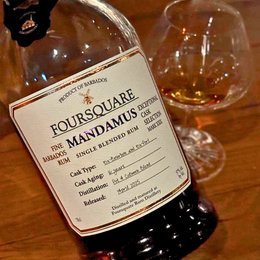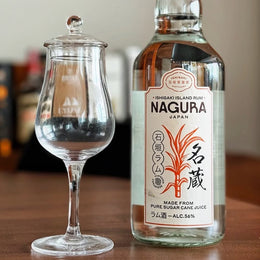(Rarest of Rare Series): The Heavy Hitters: Bally 1960 (age unknown) & Samaroli West Indies 1948 (~42 years)

Background: I recently pulled the trigger on two sets of rare rum samples curated for the upcoming TWE Rum Show. So, 5 very rare rums, 20ml each. I am planning to review all of them eventually, starting today with the two biggest names. 1960 is one of the few legendary “true Bally” (pre-Saint James) vintages, and I don’t think I need to say much about the Samaroli West Indies 1948. I am going into this tasting with a lot of hype for both rums, but significantly more for the Samaroli. After all, Signore Samaroli himself said in 1991 that this is the best spirit he has ever bottled. Yes, that is then, and this is now. But we shall see...
Name: Bally 1960 (age unknown)
Nose: very expressive; the top notes are woody and perfumey; sandalwood; potpourri; generic laundry detergent; deeper into the glass, it gets more fruity and desserty, while the funk develops in parallel; burnt hay; salted caramel; salmiak liquorice; blackforest cake; maltose syrup; coastal salinity and brine; freshly baked clay; cling wrap; gin-like botanicals with a citrusy slant -- I am reminded of Roku gin; apples, well-oxidised, maybe stewed -- there is a strong resemblance to the few calvados I have had; canned peaches; coconut shavings; overripe banana; canned pineapple; chen pi, or dried mandarin orange peel; a ton of baking spices supported by palpable wood, in a way that reminds me of an old rye whiskey; ginger candy; Nin Jiom Pei Pa Koa; the base notes are earthy, empyreumatic and industrial; aromatic incense; petrichor; coffee grounds; stir-fried chestnuts with sugar, a popular Chinese street food; peanut skin; rubber.
Palate: a very flavourful entry, with sustained and substantial intensity; cane syrup; toffee; salmiak liquorice; sarsaparilla drink; gingerbread; freshly-baked baguette; all of the aforementioned notes are accompanied by a tantalising char; stewed apples; calvados; grape Hi-chew; Älska Nordic berries cider; dried prunes and figs; raisins; maraschino cherries; tropical fruit cordial; the back-palate is sulphurous and minty; rotten eggs; human flatulence; wet metal; burning rubber and molten plastic; dit da jow; African Sea-coconut brand cough mixture.

Finish: long; burning sugarcane; sandalwood; herbal candy; liquorice; grass jelly in soymilk; strawberries and cream on a slab of fairly sweet dark chocolate bar -- Amedei Porcelana comes to mind; the aftertaste is distinctly tropical -- I detect passion fruit, mango, pineapple, pink guava -- with a pairing of baked nuts, dark chocolate, brewed coffee and orange marmalade.
Conclusion: a rhum by way of old french brandies. Poised, a little flamboyant, and with a boatload of rancio. There is nothing mind-blowing here, but the manner the pieces are put together just evokes the visceral reaction to beauty. In particular, I find the sulphurous touch on the back-palate a stroke of genius -- it livens things up without being jarring. A great rum, for sure.
Score (assuming a normal distribution with mean 50): 91/100
Name: Samaroli West Indies 1948 (~42 years)
Nose: thick and very sweet, this is almost quintessentially rum; weighty, bearing a texture that is both resinous and chalky; less expressive than the Bally, probably as a result of the top notes being dense and compact -- almost no aroma escapes the glass; buried among the top notes, is a sharp estery funk suggesting a Jamaican connection; said funk is then coated with layers of musk and must and topped with a surfeit of whipped cream; nail polish; fresh paint; wood varnish; a mish-mash of incense found at Chinese temples, with a focus on cloves; cigarette ash; tobacco; leaf compost; a waft of what one gets when opening a dusty antique wooden cabinet; hessian fabric; freshly printed documents; melting plastic; pepper-seasoned red meat; pork floss -- this is where it starts resembling the El Dorado Skeldon 2000; there is a dense grainy note that is familiar but hard to pin down -- sugar-glazed rice cracker and sweet water biscuit come close; honeydew milkshake; rockmelon; Maltesers; anise; liquorice; beneath the funk and musk and must, more confectionery notes can be found; peanut cookie; kueh bangkit, kueh lapis and other coconut-based sweets; toffee; milk chocolate hazelnut praline; Christmas cake; shortbread biscuit; the base notes comprise rotting apples a la calvados, as well as flambeed tropical fruits on the verge of rotting -- I detected bananas, jackfruit, mango and lychee, specifically.
Palate: not as thick and luscious as the nose suggests, nor is it as straightforwardly intense as the Bally; rather, its intensity increases as it moves from front- to back-palate; the front-palate is Foursquare-esque, but without the spices; caramel candy; cane syrup; fatt gou; butter cake; Indonesian kretek, or clove cigarette; dusty, antique wooden furniture dominates much of the mid-palate, punctuated by sweetened wheatgrass juice and citrus-flavoured soda; as in the Bally, things take a sulphurous on the back-palate, this time with the addition of century eggs for days, and without the metallic notes; exhaust fumes; cooking gas; minerally and earthy at the same time, like a combination of wet rocks beside a mountain spring, healthy soil, chalk, buah keluak and unsweetened chocolate.
Finish: very long; starts off fruity, green and slightly vegetal; flambeed bananas; blackforest cake; dried jackfruit; freshly-extracted latex; freshly-cut tree branches and bark; it eventually becomes minty and ointment-like; eucalyptus oil; Vick’s VapoRub; Chinese herbal “healing” salves; the aftertaste lingers with a marked clarity, mirroring a large part of the nose; I get pretty much the entire ensemble of top notes, compacted in the same orientation and "shape" as on the nose, in addition to milk chocolate, Christmas cake, shortbread biscuit, raw cake batter, and an amorphous amalgamation of coconut-based confectioneries.
Conclusion: an extremely unique rum. First, the top notes are heavy and structurally rigid, so much so that they act as a lid to keep the other aromas in the glass. Second, the aftertaste is close to a carbon copy of the nose, a copy that even takes into account weight and structure. Third, the segue into sulphurous notes on the palate arrives on short notice without throwing off the balance -- the elegance of the spirit is sure-footedly upheld, as it was in the case of the Bally. I have never come across any other spirit with the first two properties, and the Bally is the only other one with the third. If these are hallmarks of a perfect rum, then I believe this rum will not be equaled. Unfortunately, my rubrics are rather different. Perhaps high-ester rums have spoiled me, but this does not strike me as "hyper-complex", or how my whisky-drinking friends described it. The palate is also inevitably a letdown after the nose, but that is less about the palate being bad per se, than about the nose having too perfect a structure and texture. Yes, I am nitpicking here because I believe with great hype, comes great backlash, and even then, I don't find it easy in this case, at least not in good faith. Still undeniably a great rum, just not breaching 95 points by my standards.
Score (assuming a normal distribution with mean 50): 92/100
Image Courtesy of u/zoorado.
![]()
u/zoorado







